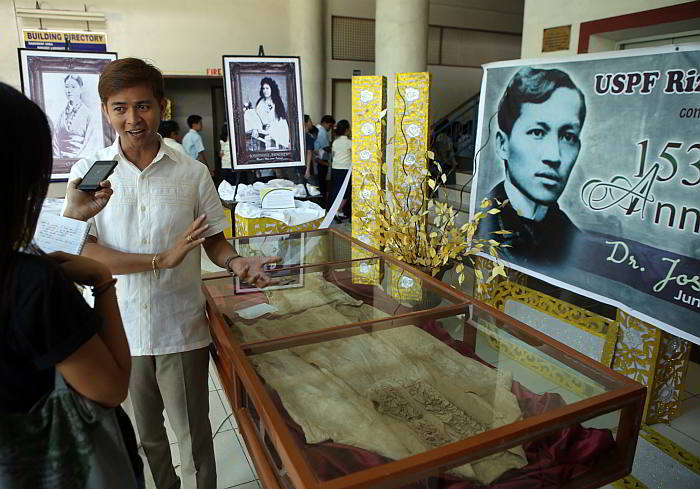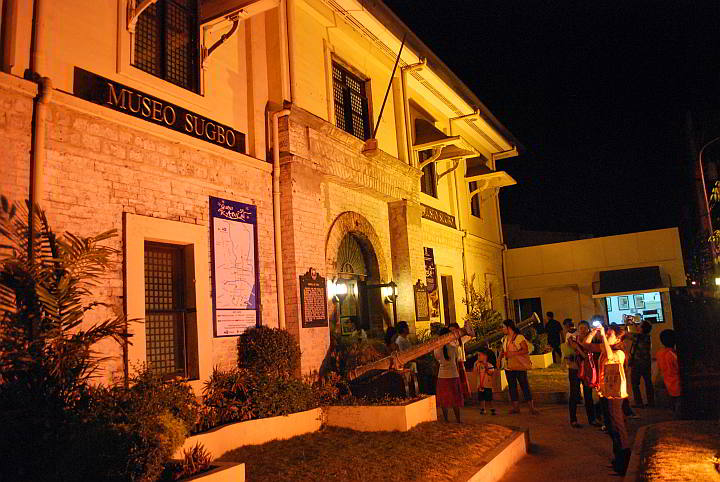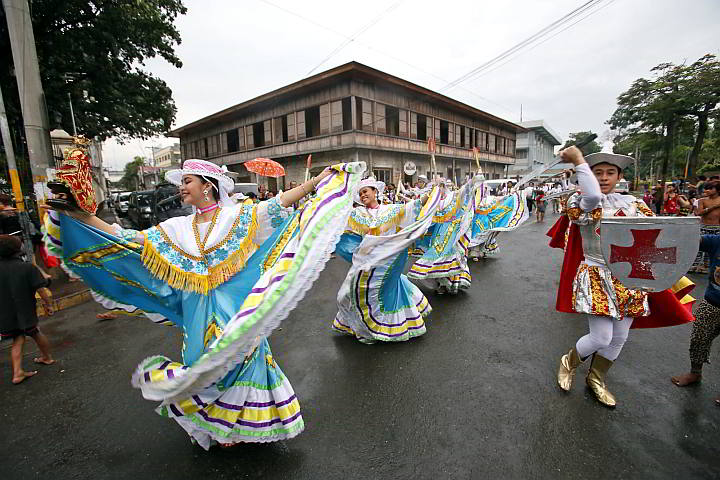On Friday, for the annual Gabii sa Kabilin, when museums and heritage sites in Metro Cebu open their doors from 6 p.m. until midnight, you can walk from one site to another in downtown Cebu City.

Dr. Alvin Zamora, curator of the USPF Museum, explains some of the wardrobe items of Jose Rizal shown in their collection in June 19, 2014 during the 153 birth anniversary of Rizal. (CDN PHOTO/LITO TECSON)
University of Southern Philippines Foundation – Rizaliana Museum
Where: Mabini Street beside the Cebu Cathedral museum
The largest collection of Jose Rizal’s memorabilia in the Visayas and Mindanao area is housed in a museum of the University of Southern Philippines Foundation (USPF).
On display: Items from Rizal’s wardrobe – winter coats, undershirts, breeches – letters and writings.
There are sketches of his sisters and 14 postcards with the text of his poem “Mi Ultimo Adios” and an original K.K.K. flag.
The school’s founders, Agustin and Beatriz Jereza, are related to our national hero through marriage ties. Through this family connection, the university was able to acquire memorabilia of Rizal. They were donated by his sister, Trinidad, to USPF in February 1951.

The Museo Parian or 1730 Jesuit House on Zulueta Street used to be a mission house of the Jesuit order.
(CDN PHOTO/ JUNJIE MENDOZA)
Museo Parian – 1730 Jesuit House
Where: Zulueta Street in barangay Tinago
On display: Three gallery collections on the San Juan Bautista Church, the Jesuit legacy, and the history of Parian, Cebu City.
The oldest dated house in the Philippines, the 1730 Jesuit House is also known as Museo Parian.
Nicanor Sy took over the property in the early 1960s for use as a warehouse. In the 1970s, his elder son discovered its heritage value in a book written by Fr. William Reppetti, SJ in his university’s library in Ateneo de Manila.
The book contained pictures of the house his father had back in Cebu. He had the place restored and opened it for public viewing in 2008.

Yap-Sandiego Ancestral House (CDN PHOTO/ JUNJIE MENDOZA)
Yap – Sandiego Ancestral House
Where: 155 Mabini Street in Parian
On display: Antiques and furniture inside give a glimpse of the lifestyle of a Cebuano family in the 18th and 19th century.
Built in the 17th century by Chinese merchants, it is one of the oldest residential structures in the Philippines.
Maria Eleuterio and Consolacion Yap resided here. Their eldest daughter, Maria Yap married the Cabeza de Barangay of Parian, Mariano Sandiego in the late 1880s. The ancestral house is in the custody of choreographer Val Sandiego, who keeps it open to the public for heritage viewing.

Museo Sugbo
Museo Sugbo
Where: M.J. Cuenco Avenue in barangay Tejero
With its 14 galleries, Museo Sugbo of the Cebu provincial government is the largest museum in Cebu. It used to serve as the provincial jail until 2004.
On display: Galleries trace Cebu’s history from the pre-colonial period up to the Japanese periods. The Abellana Memorabilia Gallery, the Vicente Rama Memorabilia Gallery, The Cebu Media Gallery, the Rosita Arcenas Ecclesiastical Collection, the National Historical Commission – Cebu Branch, the National Archives of the Philippines and more.
Much of the structure came from coral stone blocks from the demolished Parian Church. It was designed in 1969 as the main prison for the Visayas, the Cárcel de Cebú.

Cebu Cathedral Museum
Archdiocesan Museum of Cebu (Cebu Cathedral Museum)
Where: Corner Mabini and Urdaneta Streets next the Cebu Metropolitan Cathedral
On display: Photo exhibits, antique images of saints, a Spanish-period silver altar piece, other artifacts from the colonial era, memorabilia of Ricardo Cardinal Vidal.
The ecclesiastical museum of the Roman Catholic Church’s Archdiocese of Cebu used to be a convent.
Galleries show the growth of the Catholic faith in the island and how churches were constructed in the Spanish era through photos and actual building materials./ Alexandra Munoz, STC
Disclaimer: The comments uploaded on this site do not necessarily represent or reflect the views of management and owner of Cebudailynews. We reserve the right to exclude comments that we deem to be inconsistent with our editorial standards.




